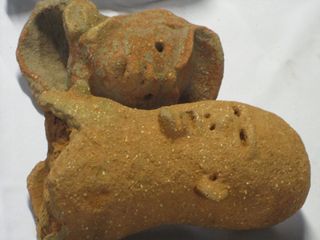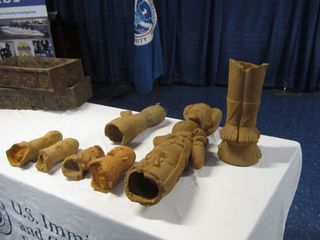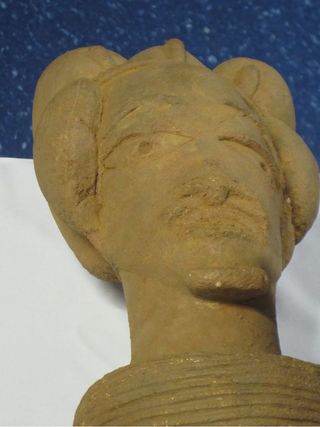Ancient Statues Smuggled from Nigeria to Return Home

NEW YORK — A handful of roughly 2,000-year-old figurines began a journey back home to Nigeria today (July 26) after being seized at John F. Kennedy Airport in New York City.
At a repatriation ceremony held at Homeland Security Investigation offices on the west side of Manhattan, Nigeria's Consul General Habib Baba Habu took legal possession of the terracotta sculptures, which he said had been stolen from the country's national museum.
Habu called today a special day. "It is the day that America has extended a gift of friendship that we will never forget," he said.

Ancient artifacts
On display for the ceremony were seven pieces of figurines, which resembled bits of cylindrical gingerbread men thanks to the orange hue of the terracotta. The two best preserved pieces, a head and torso, and a pair of legs standing on a pedestal, appeared to have once belonged to a single figure.
All are the work of the Nok culture, which existed within what would become Nigeria from more than 2,000 years ago, before disappearing in the early centuries of the first millennium. (Timeframes for their existence vary.) [Image Gallery: Ancient Rock Art of Sudan]
Each of the six terracotta heads bore a distinctive face, which is typical of Nok sculpture, Habu said, explaining that the ancient artisans drew from individual people in normal life, depicting them riding horses or donkeys, for example, or with farm tools.
Sign up for the Live Science daily newsletter now
Get the world’s most fascinating discoveries delivered straight to your inbox.
Nok artisans were prolific, many similar figurines have left Nigeria, Habu said: "Many of them are at museums all over the world, some were taken out legally."
Nigeria has laws that control the export of Nok pieces; however, the sculptures have flooded out of the country. In the 1990s, so many reached the European art market that the prices dropped sharply, according to a New York Times article in 2000.
A modern journey
During today's ceremony, two ornate, hardwood boxes sat near the figures. The statues had been packed within these boxes while being shipped as air cargo into the United States.
During a routine inspection in Charles de Gaulle Airport in Paris more than a year ago, French customs officers spotted the statues. Although they could not seize them, they notified Homeland Security Investigations (HSI) and Customs and Border Protection (CBP) in New York, the items' destination. American officials met the suspicious cargo when it arrived, officials said.
An investigation has since verified that these sculptures were cultural artifacts, not handy crafts and personal effects as described on customs' documents. That investigation is ongoing, and officials declined to give details on who they believed was responsible for attempting to smuggle the items into the United States.
"Often times brokers here in the United States receive a large number of shipments for a large number of people then distribute them. Often times, they have very little to do with the actual shipment," said James Hayes, special agent in charge of HSI New York.
This appears to be the case in this instance, said Robert Perez, director of CBP's New York Field Operations.
It's not yet clear who was responsible for removing them from Nigeria.
"From what we know the items were stolen from the national museum in Nigeria," Habu said. "There is no report of the items being stolen so now the director-general of the Nigerian museum and antiquities is now being subjected to an investigation." [Faux Real: A Gallery of Art Forgeries]

Returning home
American officials plan to also return three additional items — two more Nok figurines and a carved ivory tusk — that were seized in Chicago.
Habu said he plans to have everything shipped back to Nigeria in August, where they will be returned to the museum.
He pointed to the two matching pieces, which appeared to have come from a single figurine.
"I am going to ask the government if they will agree to get expert restorers to put this back," he said.
Officials declined to assign a monetary value to the statues, saying as cultural artifacts they are priceless.
Follow Wynne Parry on Twitter @Wynne_Parry or LiveScience @livescience. We're also on Facebook & Google+.
Most Popular


